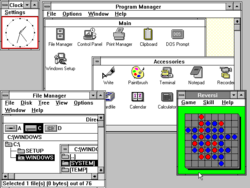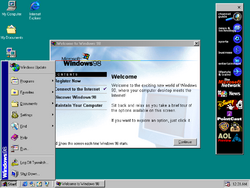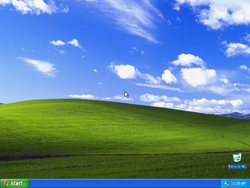Windows
Windows is a Microsoft product that began as an operating environment that slowly evolved into a full-fledged operating system and has since become the most popular operating system for home computers. By the early 1990s Windows began to overtake DOS because of its more friendly graphical user interface. Games have been made for Windows all through it's history, but they didn't start to become mainstream until after Windows 95 was released.
Because Windows is an evolving platform games tend to work on multiple versions of the software. In general, Windows exists in three blocks, 16-bit, 32-bit, and 64-bit, and games targeted to a block tends to work in each block. However, due to the nature of drivers, DLLs, etc., games are sometimes fickle even within a block. When documenting a Windows game, try to include which versions of Windows the game will work with.
Contents
Versions
Over the years, Windows has been released in a large variety of versions and flavors, however in order to simplify things, the Video Game Music Preservation Foundation has grouped them into smaller categories.
Early Windows
| Windows 1, 2 | |
 |
|
| Released: | 1985-11-20 |
| Discontinued: | 2001-12-31 |
| Developer: | Microsoft |
| Type: | Software |
This early block of Windows included versions 1 and 2; both were operating environments that ran from DOS. There are no known games that were released for these platforms that include music.
Windows 16-bit
| Windows 3, 3.1, 3.11 | |
 |
|
| Released: | 1990-05-22 |
| Discontinued: | 2001-12-31 |
| Developer: | Microsoft |
| Type: | Software |
The 16-bit block of Windows included versions 3.0, 3.1, and 3.11. It was the first popular version of Windows and was sold on the majority of PCs in the early 1990s. Windows 3.x featured stronger multimedia support than the previous versions of Windows allowing for various types of music and sound effects to be played. Unfortunately, Windows 3.x had poor graphic support and most users experienced it with a mere 16 colors and a fixed 640x480 screen resolution. Some of the later updates of Windows 3.11 included higher resolution graphics and more colors, though not many games took advantage of this.
After random boots, a MIDI mapper shows up in the Control Panel, where you can map every MIDI channel (out of all 16) to another driver. Windows 3.x came with two items:
- "Base" and "Extended" configurations. Games came either with Base MIDI files, Extended MIDI files, MIDI files that combine both, or two sets of MIDI files.
- An "Ad Lib" driver. Some MIDI files sound only good there, whereas on everything else, you hear unrealistic instruments and unequalized volumes. Games include Dare to Dream and probably Dracula In London (W16).
Windows 32-bit
| Windows 95, 98, ME | |
 |
|
| Released: | 1995-08-24 |
| Discontinued: | 2001-12-31 |
| Developer: | Microsoft |
| Type: | Software |
The 32-bit Windows block included the versions 95, 98, and ME. These versions of Windows were full-fledged operating systems and only used DOS as a bootstrapper. With this block of Windows, multimedia was vastly improved thanks to APIs like DirectX. Support for 32 bit color was added, high-resolution graphics became the norm, and network capabilities were vastly improved. The 32-bit era of Windows saw the death of DOS gaming, as every major development company switched off of DOS during this era.
The MIDI mapper has been replaced by a list of MIDI music playback devices, of which you can select a default. VGMPF currently does not remember any available devices as of 1995. In 1996, Microsoft added the now-infamous Microsoft GS Wavetable SW Synth to DirectX and all subsequent Windows versions.
Windows XP
| Windows NT, 2000, XP | |
 |
|
| Released: | 2001-10-25 |
| Discontinued: | 2014-04-08 |
| Developer: | Microsoft |
| Type: | Software |
The most popular released of Windows has been Windows XP which was based on the earlier incarnations NT and 2000. However, while NT and 2000 were targeted more for business use, Windows XP was targeted for home users as well. The version featured a major upgrade to the kernel, including a 64-bit version, and several improvements to multimedia capabilities, networking, and security. Windows XP is a self-contained OS that didn't use DOS for bootstrapping. However, these added improvements came at a price which prevented certain older Windows games from running in XP. Those games for the 32-bit platform that didn't require complicated graphics tend to work on the XP platform as well.
The Windows 3.x way of playing MIDI files has changed, more notably for the worse. At least in early Windows XP installations, each song is delayed by about one second. When started from a specific position, notes get skipped or switched to piano.
Windows 64-bit
| Windows Vista, 7, 8, 8.1, 10, 11 | |
 |
|
| Released: | 2006-11-30 |
| Developer: | Microsoft |
| Type: | Software |
This block features Vista, 7, 8, 8.1, 10, and 11. Windows Vista flopped into the market disappointing many people. While it added several improvements to gaming, it also broke backward compatibility with numerous Windows XP games, and hogged all the system resources, causing games to run slower. Thankfully, Windows 7 fixed most of those problems and added a richer gaming experience overall. However, there are still several XP games that cannot run on Windows 7, and more new games that will run on Windows 7, but not XP, are appearing. Windows 8 is essentially Windows 7 with an overhauled interface to make it more friendly on touchscreen displays. Little was changed that affects the gaming or multimedia experience, and nearly every game that worked in Windows 7 will work in 8. Windows 10 is mostly back-ward compatible with Windows 7 and 8. Windows 11 has been the latest current release.
While first Windows system build as 64-bit appeared in 2006, the ultimate success of Windows XP has lead developers to continue making 32-bit games so they could be played both on 32-bit and 64-bit platforms. In 2014-2015, when the end of Windows XP support has forced users to move onto 64-bit platforms, and few years after that, professional games have aborted 32-bit compatibility in favor of utilizing more RAM. However, as of 2023 it's still common to make games and programs that don't require too many RAM to be compatible with 32-bit architecture.
Unfortunately, the default MIDI music playback device selection has become hidden from the user.
Music and Sound
Since Windows is a software platform, it doesn't have any audio capabilities, however, most audio devices manufactured since the early 1990s have been made to be compatible with Windows. Here is a list of some of the more popular ones from the early 1990s:
- Roland: MT-32, LAPC-I
- Media Vision: Pro AudioSpectrum, Pro AudioSpectrum 16
- Creative: Sound Blaster, Sound Blaster Pro, Sound Blaster 16, Sound Blaster AWE 32
- Gravis: UltraSound
- Disney: Sound Source
- Ad Lib: AdLib
- Tandy 1000: Tandy 3 Voice, Tandy DAC,
In the late 1990s and beyond, most motherboards were being manufacturer with built-in audio devices capable of playing fully digital music and sound.
Links
- en.wikipedia.org/wiki/Microsoft_Windows - Wikipedia.